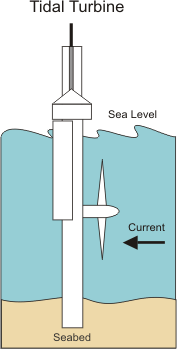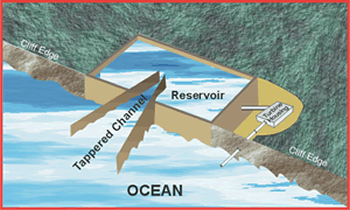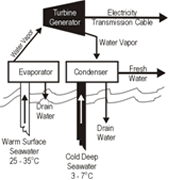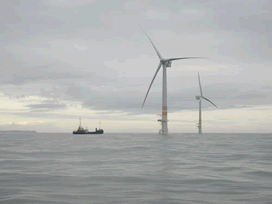|
Ocean
Energy
See
also:
other
readings with assessment in Alternative Energy --
Wind Energy -- Geothermal Energy -- Hydropower -- Nuclear
Energy --
see
Alternative Energy Basics
|
|
|
Ocean Energy
Tidal
Energy
Tides are
caused by the gravitational pull of the moon and sun, and the
rotation of the earth. Near shore, water levels can vary up to
40 feet. Only about 20 locations have good inlets and a large
enough tidal range- about 10 feet- to produce energy economically.
The simplest generation system for tidal plants involves a dam,
known as a barrage, across an inlet. Sluice gates on the barrage
allow the tidal basin to fill on the incoming high tides and to
empty through the turbine system on the outgoing tide, also known
as the ebb tide. There are two-way systems that generate electricity
on both the incoming and outgoing tides.
Tidal barrages
can change the tidal level in the basin and increase turbidity
in the water. They can also affect navigation and recreation.
Potentially the largest disadvantage of tidal power is the effect
a tidal station can have on plants and animals in the estuaries.
There are
currently two commercial sized barrages in operations. One is
located in La Rance, France; the other is in Annapolis Royal,
Nova Scotia, Canada.  The US has no tidal plants and only a few sites where tidal
energy could be produced economically. France, England, Canada,
and Russia have much more potential.
The US has no tidal plants and only a few sites where tidal
energy could be produced economically. France, England, Canada,
and Russia have much more potential.
Tidal fences
can also harness the energy of tides. A tidal fence has vertical
axis turbines mounted in a fence. All the water that passes is
forced through the turbines. They can be used in areas such as
channels between two landmasses. Tidal fences have less impact
on the environment than tidal barrages although they can disrupt
the movement of large marine animals. They are cheaper to install
than tidal barrages too. A tidal fence is planned for the San
Bernardino Strait in the Philippines.
Tidal turbines
are a new technology that can be used in many tidal areas. They
are basically wind turbines that can be located anywhere there
is strong tidal flow. Because water is about 800 times denser
than air, tidal turbines will have to be much sturdier than wind
turbines. They will be heavier and more expensive to build but
will be able to capture more energy.
Wave
Energy
Waves are
caused by the wind blowing over the surface of the ocean. There
is tremendous energy in the ocean waves. The total power of waves
breaking around the world’s coastlines is estimated at 2-3 million
megawatts. The west coasts of the US and Europe and the coasts
of Japan and New Zealand are good sites for harnessing wave energy.

One way to
harness wave energy is to bend or focus the waves into a narrow
channel, increasing their power and size. The waves can then be
channeled into a catch basin or used directly to spin turbines.
There are no big commercial wave energy plants, but there are
a few small ones. Small, on-shore sites have the best potential
for the immediate future; they could produce enough energy to
power local communities. Japan, which imports almost all of its
fuel, has an active wave-energy program.
Ocean
Thermal Energy Conversion (OTEC)
 The energy from the sun heats
the surface water of the ocean. In tropical regions, the surface
water can be 40 or more degrees warmer than the deep water. This
temperature difference can be used to produce electricity. The
OTEC system must have a temperature difference of at least 25
degrees Celsius to operate, limiting use to tropical regions.
Hawaii has experimented with OTEC since the 1970’s. There is no
large-scale operation of OTEC today. There are many challenges.
First, the OTEC systems are not very energy efficient. Pumping
water is a giant engineering challenge. Electricity must also
be transported to land. It will probably be 10 to 20 years before
the technology is available to produce and transmit electricity
economically from OTEC systems.
The energy from the sun heats
the surface water of the ocean. In tropical regions, the surface
water can be 40 or more degrees warmer than the deep water. This
temperature difference can be used to produce electricity. The
OTEC system must have a temperature difference of at least 25
degrees Celsius to operate, limiting use to tropical regions.
Hawaii has experimented with OTEC since the 1970’s. There is no
large-scale operation of OTEC today. There are many challenges.
First, the OTEC systems are not very energy efficient. Pumping
water is a giant engineering challenge. Electricity must also
be transported to land. It will probably be 10 to 20 years before
the technology is available to produce and transmit electricity
economically from OTEC systems. 
Solar
Research is
being done to place solar farms over the ocean. With oceans making
up 70 percent of the earth’s surface, some people believe near
the coasts would be a perfect place for solar farms. Currently,
solar energy is used on offshore platforms and to operate remotely
located equipment at sea. Solar energy is a renewable energy source,
is free and does not pollute. Visit the solar
section of the site for more on solar.
Wind
Wind energy,
like solar energy is already used on land. Wind turbines, and
wind farms can only be placed where the wind constantly blows.
Along the coast of much of the US , conditions are well suited
to use wind energy. There are people who are opposed to putting
turbines just offshore. People think the turbines will spoil the
view of the ocean. Right now, there is a plan to build an offshore
wind plant off the coast of Cape Cod , MA. Wind is a renewable
energy source that does not pollute so some people see it as a
good alternative to fossil fuels. To learn more about wind, visit
the wind
section of the site.

